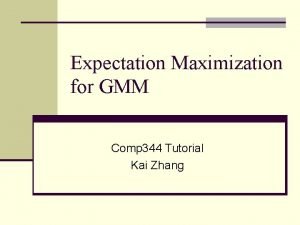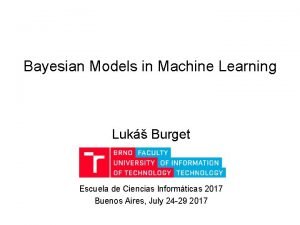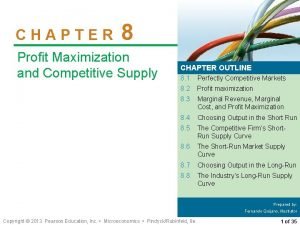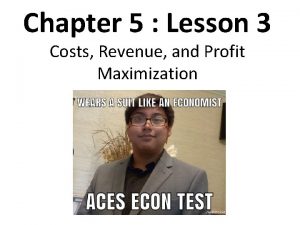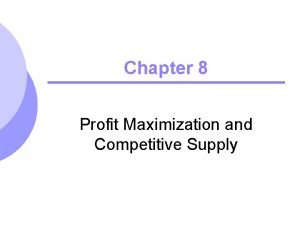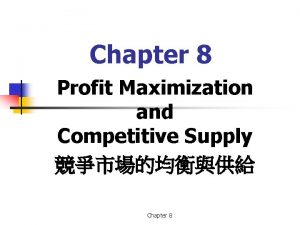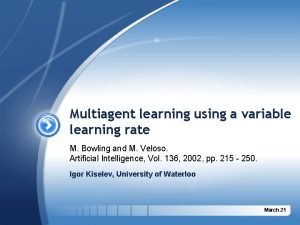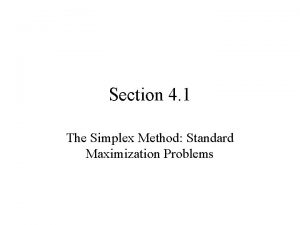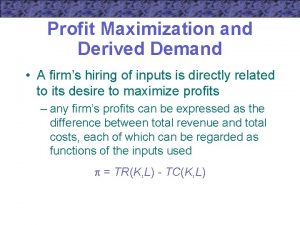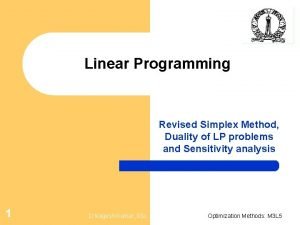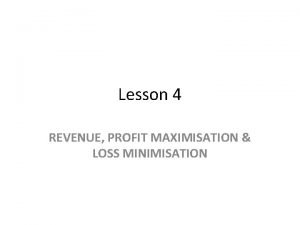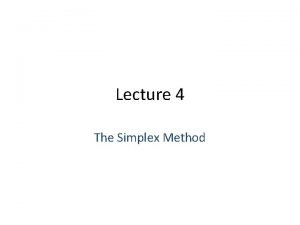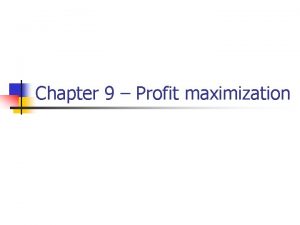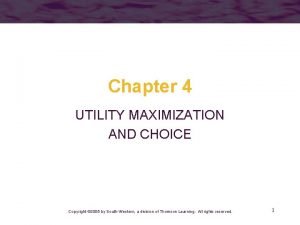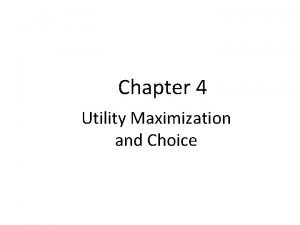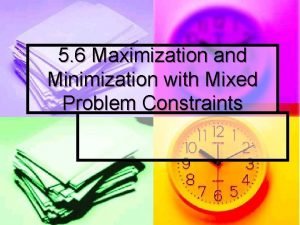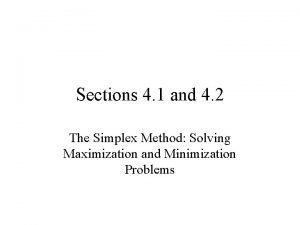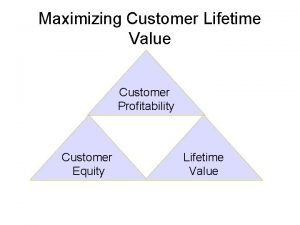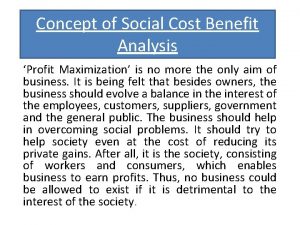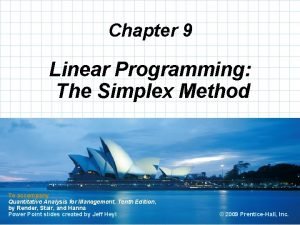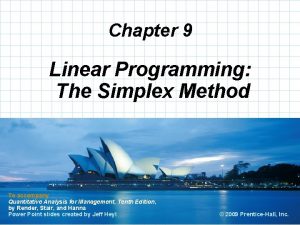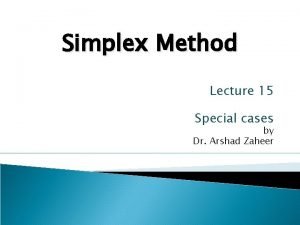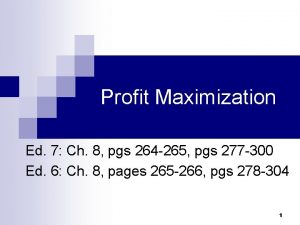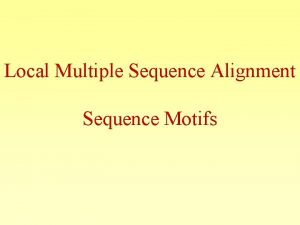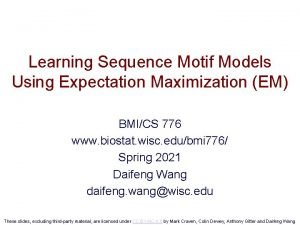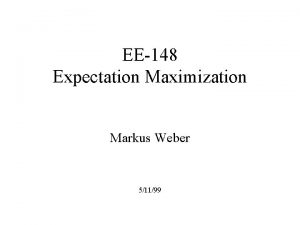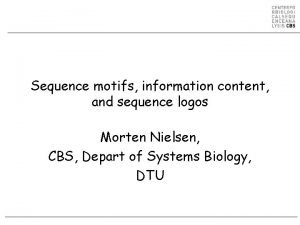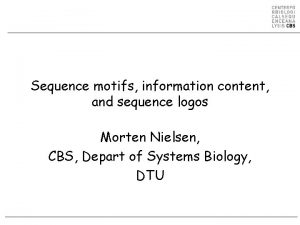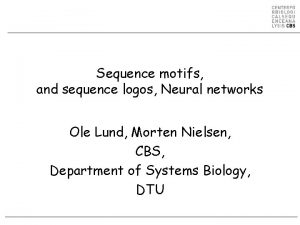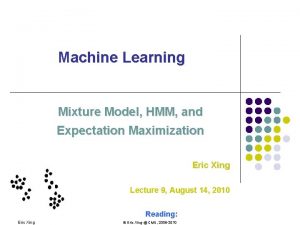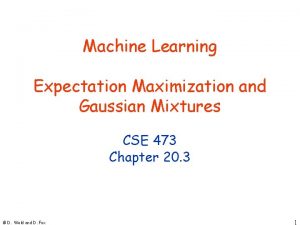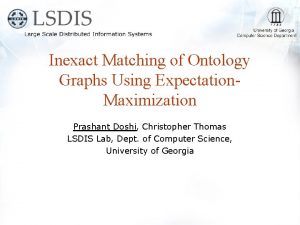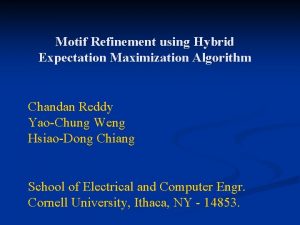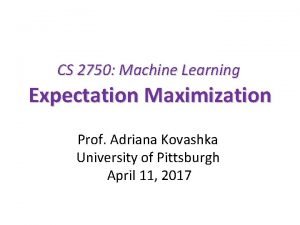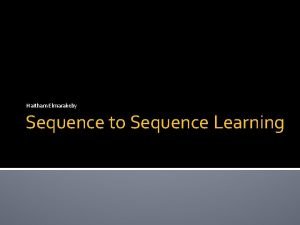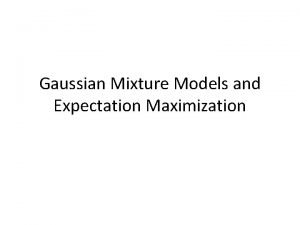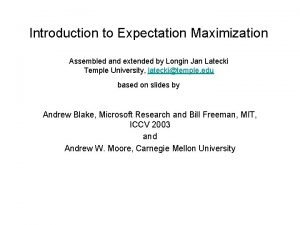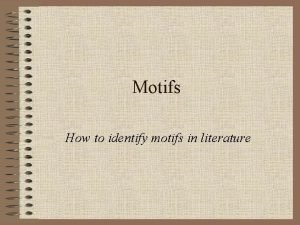Learning Sequence Motifs Using Expectation Maximization EM and


































- Slides: 34

Learning Sequence Motifs Using Expectation Maximization (EM) and Gibbs Sampling BMI/CS 776 www. biostat. wisc. edu/~craven/776. html Mark Craven craven@biostat. wisc. edu March 2002

Announcements • HW due on Monday • reading for next week – Chapter 3 of Durbin et al. (already assigned) – Krogh, An Introduction to HMMs for Biological Sequences • is everyone’s account set up? • did everyone get the Lawrence et al. paper?

Sequence Motifs • what is a sequence motif ? – a sequence pattern of biological significance • examples – protein binding sites in DNA – protein sequences corresponding to common functions or conserved pieces of structure

Motifs and Profile Matrices • given a set of aligned sequences, it is straightforward to construct a profile matrix characterizing a motif of interest shared motif sequence positions 1 2 3 4 5 6 7 8 A 0. 1 0. 3 0. 1 0. 2 0. 4 0. 3 0. 1 C 0. 5 0. 2 0. 1 0. 6 0. 1 0. 2 0. 7 G 0. 2 0. 6 0. 5 0. 1 0. 2 0. 1 T 0. 2 0. 3 0. 2 0. 1 0. 3 0. 1

Motifs and Profile Matrices • how can we construct the profile if the sequences aren’t aligned? – in the typical case we don’t know what the motif looks like • use an Expectation Maximization (EM) algorithm

The EM Approach • EM is a family of algorithms for learning probabilistic models in problems that involve hidden state • in our problem, the hidden state is where the motif starts in each training sequence

The MEME Algorithm • Bailey & Elkan, 1993 • uses EM algorithm to find multiple motifs in a set of sequences • first EM approach to motif discovery: Lawrence & Reilly 1990

Representing Motifs • a motif is assumed to have a fixed width, W • a motif is represented by a matrix of probabilities: represents the probability of character c in column k • example: DNA motif with W=3 A C G T 1 0. 4 0. 3 0. 2 2 0. 5 0. 2 0. 1 0. 2 3 0. 2 0. 1 0. 6 0. 1

Representing Motifs • we will also represent the “background” (i. e. outside the motif) probability of each character • represents the probability of character c in the background • example: A C G T 0. 26 0. 24 0. 23 0. 27

Basic EM Approach • the element of the matrix represents the probability that the motif starts in position j in sequence I • example: given 4 DNA sequences of length 6, where W=3 seq 1 seq 2 seq 3 seq 4 1 0. 4 0. 3 0. 1 2 0. 1 0. 5 3 0. 2 0. 1 0. 5 0. 1 4 0. 6 0. 3 0. 1 0. 3

Basic EM Approach given: length parameter W, training set of sequences set initial values for p do re-estimate Z from p (E –step) re-estimate p from Z (M-step) until change in p < e return: p, Z

Basic EM Approach • we’ll need to calculate the probability of a training sequence given a hypothesized starting position: before motif is the ith sequence is 1 if motif starts at position j in sequence i is the character at position k in sequence i after motif

Example G C T G T A G A C G T 0 0. 25 1 0. 4 0. 3 0. 2 2 0. 5 0. 2 0. 1 0. 2 3 0. 2 0. 1 0. 6 0. 1

The E-step: Estimating Z • to estimate the starting positions in Z at step t • this comes from Bayes’ rule applied to

The E-step: Estimating Z • assume that it is equally likely that the motif will start in any position

Example: Estimating Z G C T G T A G A C G T 0 0. 25 1 0. 4 0. 3 0. 2 . . . • then normalize so that 2 0. 5 0. 2 0. 1 0. 2 3 0. 2 0. 1 0. 6 0. 1

The M-step: Estimating p • recall represents the probability of character c in position k ; values for position 0 represent the background pseudo-counts total # of c’s in data set

Example: Estimating p A C A G C A A G G C A G T C

The EM Algorithm • EM converges to a local maximum in the likelihood of the data given the model: • usually converges in a small number of iterations • sensitive to initial starting point (i. e. values in p)

MEME Enhancements to the Basic EM Approach • MEME builds on the basic EM approach in the following ways: – trying many starting points – not assuming that there is exactly one motif occurrence in every sequence – allowing multiple motifs to be learned – incorporating Dirichlet prior distributions

Starting Points in MEME • for every distinct subsequence of length W in the training set – derive an initial p matrix from this subsequence – run EM for 1 iteration • choose motif model (i. e. p matrix) with highest likelihood • run EM to convergence

Using Subsequences as Starting Points for EM • set values corresponding to letters in the subsequence to X • set other values to (1 -X)/(M-1) where M is the length of the alphabet • example: for the subsequence TAT with X=0. 5 A C G T 1 0. 17 0. 5 2 0. 5 0. 17 3 0. 17 0. 5

The ZOOPS Model • the approach as we’ve outlined it, assumes that each sequence has exactly one motif occurrence per sequence; this is the OOPS model • the ZOOPS model assumes zero or one occurrences per sequence

E-step in the ZOOPS Model • we need to consider another alternative: the ith sequence doesn’t contain the motif • we add another parameter (and its relative) § prior prob that any position in a sequence is the start of a motif § prior prob of a sequence containing a motif

E-step in the ZOOPS Model • here is a random variable that takes on 0 to indicate that the sequence doesn’t contain a motif occurrence

M-step in the ZOOPS Model • update p same as before • update as follows • average of across all sequences, positions

The TCM Model • the TCM (two-component mixture model) assumes zero or more motif occurrences per sequence

Likelihood in the TCM Model • the TCM model treats each length W subsequence independently • to determine the likelihood of such a subsequence: assuming a motif starts there assuming a motif doesn’t start there

E-step in the TCM Model subsequence isn’t a motif • M-step same as before subsequence is a motif

Finding Multiple Motifs • basic idea: discount the likelihood that a new motif starts in a given position if this motif would overlap with a previously learned one • when re-estimating , multiply by • is estimated using passes of motif finding values from previous

Gibbs Sampling • a general procedure for sampling from the joint distribution of a set of random variables by iteratively sampling from for each j • application to motif finding: Lawrence et al. 1993 • can view it as a stochastic analog of EM for this task • less susceptible to local minima than EM

Gibbs Sampling Approach • in the EM approach we maintained a distribution over the possible motif starting points for each sequence • in the Gibbs sampling approach, we’ll maintain a specific starting point for each sequence but we’ll keep resampling these

Gibbs Sampling Approach given: length parameter W, training set of sequences choose random positions for a do pick a sequence estimate p given current motif positions a (update step) (using all sequences but ) sample a new motif position for (sampling step) until convergence return: p, a

Sampling New Motif Positions • for each possible starting position, weight , compute a • randomly select a new starting position these weights according to
 Expectation maximization tutorial
Expectation maximization tutorial Expectation maximization algorithm
Expectation maximization algorithm Convolutional sequence to sequence learning
Convolutional sequence to sequence learning Profit maximization and competitive supply
Profit maximization and competitive supply Cost revenue and profit maximization guided reading
Cost revenue and profit maximization guided reading Profit maximization and competitive supply
Profit maximization and competitive supply Profit maximization and competitive supply
Profit maximization and competitive supply Multiagent learning using a variable learning rate
Multiagent learning using a variable learning rate Cuadro comparativo de e-learning b-learning y m-learning
Cuadro comparativo de e-learning b-learning y m-learning Differentiate finite sequence and infinite sequence
Differentiate finite sequence and infinite sequence Different types of irony
Different types of irony Standard maximization problem
Standard maximization problem Monopsony profit maximization
Monopsony profit maximization Limitations of profit maximization
Limitations of profit maximization Revised dual simplex method
Revised dual simplex method Perfectly competitive firm profit maximization
Perfectly competitive firm profit maximization Simplex method problem
Simplex method problem Profit
Profit Marshallian demand function
Marshallian demand function Quasi linear utility function
Quasi linear utility function Big m method minimization with mixed constraints
Big m method minimization with mixed constraints Revised simplex calculator
Revised simplex calculator Module 53 featured worksheet profit maximization
Module 53 featured worksheet profit maximization Wealth maximization
Wealth maximization Maximizing customer lifetime value
Maximizing customer lifetime value Financial management definition
Financial management definition Benefits of profit maximization
Benefits of profit maximization The zj row in a simplex table for maximization represents
The zj row in a simplex table for maximization represents In simplex table the pivot row is computed by
In simplex table the pivot row is computed by Unit 2 demand supply and consumer choice
Unit 2 demand supply and consumer choice Simplex method special cases
Simplex method special cases Profit maximization
Profit maximization Profit maximization
Profit maximization Nucleotide to amino acid
Nucleotide to amino acid Pseudocode for repetition
Pseudocode for repetition
